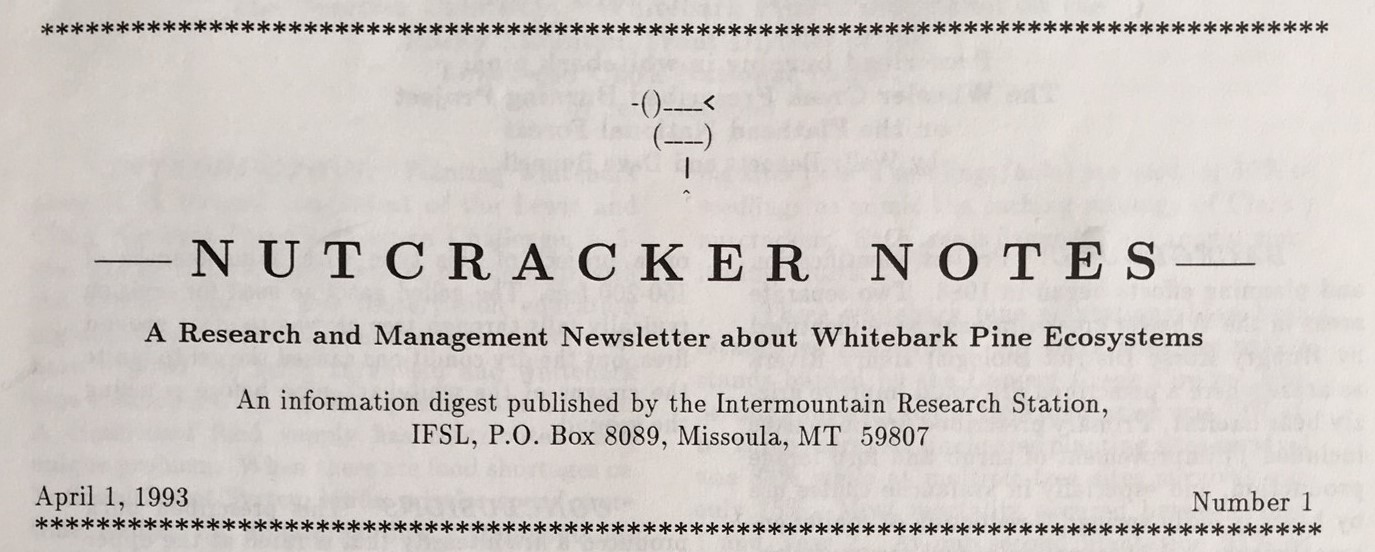
Way Back Whitebark-March 1994
Pruning Whitebark Pine to Reduce Blister Rust May Not Be Recommended
By Cathy Stewart and John Schwandt
This article appeared in a March 1994 issue of Nutcracker Notes
INTRODUCTION: Pruning of western white pine has been shown to be particularly effective in improving white pine survival and volume, especially in areas of moderate rust hazard, because pruning removes the branch cankers that would otherwise kill the tree. Therefore, surveys were conducted on the Bitterroot National Forest last year to determine if similar treatments might be worthwhile in stands of whitebark pine. The surveys were funded with Forest Pest Management pre-suppression funds to determine the potential need for pruning white pine blister rust cankers and to delineate areas for treatment.
METHODS: Surveys were a combination of stand exam plots and walk-through formats. Procedures called for adapting the basic stand exam to include some additional blister rust information that would help determine infection levels. Location of branch cankers was used to classify trees as prunable (cankers 6-24 inches from bole), lethally infected (cankers more than 6 inches from the bole) or safe (cankers greater than 24 inches from the bole).
RESULTS: Stand exam crews on the Stevensville and Darby Ranger Districts surveyed 1,500 acres and 1,300 acres, respectively, of high elevation stands to determine the status of whitebark pine and the potential need for canker pruning. Stand conditions were highly variable with measurable impacts from the 1920’s mountain pine beetle outbreak, fire suppression and white pine blister rust infection. Whitebark pine was found to be more prevalent on south aspects in the Sapphire Mountains on the Bitterroot National Forest with subalpine fir and Douglas-fir more common on the north aspects. Many stands were composed of dead whitebark pine (due to 1920’s mountain pine beetle outbreak and some more recent blister rust mortality) in the overstory with subalpine fir encroaching in the understory. The blister rust infection levels were heavier in the Bitterroot Mountains on the west side of the Forest compared to the Sapphire Mountains on the east side and were also heavier on the north end of the Forest compared to the south end. The data showed that many sapling trees were heavily infected and that only a small portion were prunable. Most infections were well within 24 inches of the bole, and many were less than 6 inches from the bole.
DISCUSSION: Pruning and thinning were accomplished on an experimental basis but pruning was determined to be less feasible. After a meeting in the field with several pathologists and foresters, we decided that pruning would NOT be advised in these stands because there were very few prunable trees, and pruning would be contrary to stands developing natural resistance to blister rust. Ray Hoff has found that white bark pine stands are developing resistance, and that pruning of susceptible trees would only prolong this natural function by maintaining susceptible genotypes for longer periods of time. At this time we are not sure if this decision would be applicable in all stands, but suspect it might be the case in many stands. However, pruning might have a role in areas where we might be faced with total elimination of whitebark pine by blister rust before resistance can develop. Thinning to favor whitebark pine over subalpine fir, Douglas-fir and lodgepole pine appears to be a feasible method to improve the survival of whitebark pine in these ecosystems. The effects of these treatments should be monitored, however, since thinning has been shown to increase infection rates in western white pine.
This article appeared in a March 1994 issue of Nutcracker Notes

